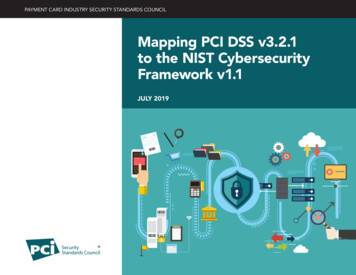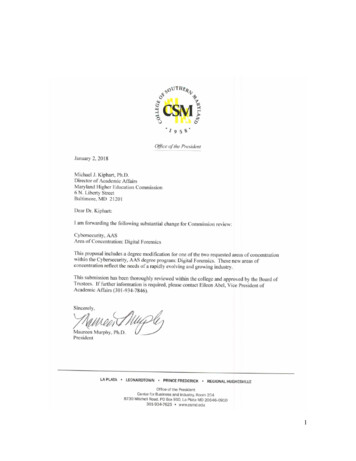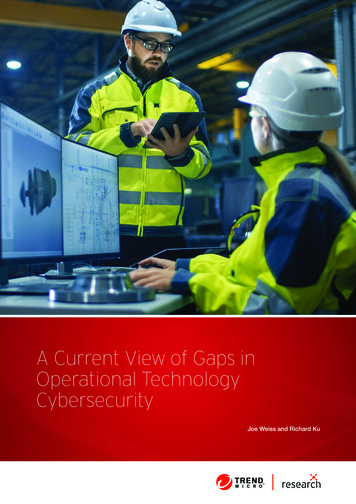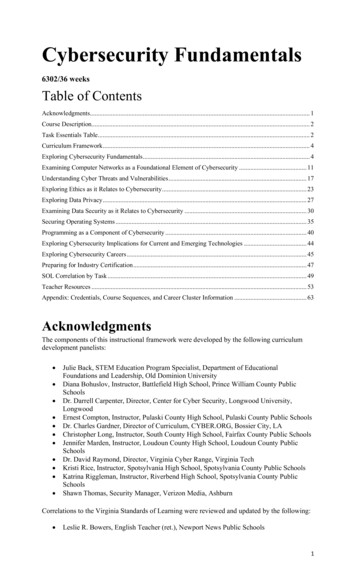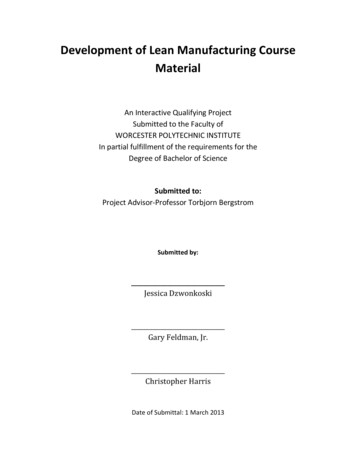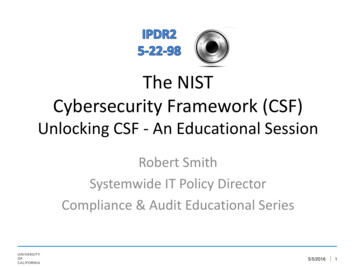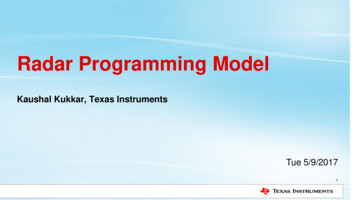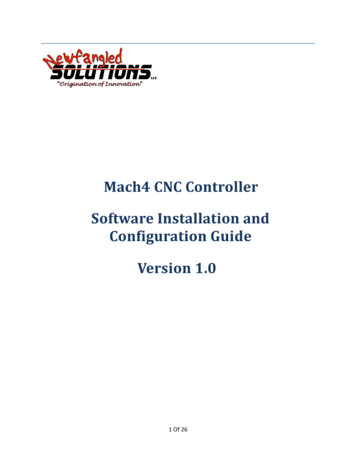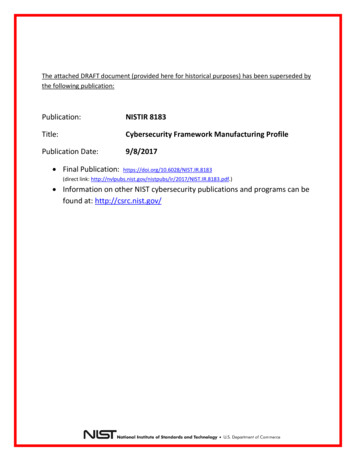
Transcription
The attached DRAFT document (provided here for historical purposes) has been superseded bythe following publication:Publication:NISTIR 8183Title:Cybersecurity Framework Manufacturing ProfilePublication Date:9/8/2017 Final irect link: 183.pdf.) Information on other NIST cybersecurity publications and programs can befound at: http://csrc.nist.gov/
The following information was posted with the attached DRAFT document:Mar 20, 2017WhitepaperDRAFT Cybersecurity Framework Manufacturing Profile (Final Draft)A draft manufacturing implementation of the Cybersecurity Framework, or Profile, hasbeen developed for reducing cybersecurity risk for manufacturers that is aligned withmanufacturing sector goals and industry best practices. This Manufacturing"Target" Profile focuses on desired cybersecurity outcomes and can be used to identifyopportunities for improving the current cybersecurity posture of a manufacturing system.This Manufacturing Profile provides a voluntary, risk-based approach for managingcybersecurity activities and reducing cyber risk to manufacturing systems. TheManufacturing Profile is meant to enhance but not replace current cybersecuritystandards and industry guidelines that the manufacturer is embracing.The public comment period closes on: April 17, 2017.Send comments to csf manufacturing profile at nist.gov.
CYBERSECURITY FRAMEWORKMANUFACTURING PROFILEMarch 20, 2017
FINAL PUBLIC DRAFTMARCH 20, 2017CYBERSECURITY FRAMEWORKMANUFACTURING PROFILETable of ContentsExecutive Summary . 21.Introduction . 31.1 Purpose & Scope . 31.2 Audience . 41.3 Document Structure . 42.Overview of Manufacturing Systems . 53.Overview of the Cybersecurity Framework . 63.1 Framework Core . 64.Manufacturing Profile Development Approach . 95.Manufacturing Business/Mission Objectives . 105.1 Alignment of Subcategories to Meet Mission Objectives . 106.Manufacturing System Categorization and Risk Management . 156.1 Categorization Process . 156.2 Profile’s Hierarchical Supporting Structure . 176.3 Risk Management . 177.Manufacturing Profile Subcategory Guidance . 18Appendix A - Acronyms and Abbreviations . 47Appendix B - Glossary . 48Appendix C - References . 521
FINAL PUBLIC DRAFTMARCH 20, 2017CYBERSECURITY FRAMEWORKMANUFACTURING PROFILEExecutive SummaryThis document provides the Cybersecurity Framework implementation details developed for themanufacturing environment. The “Manufacturing Profile” of the Cybersecurity Framework canbe used as a roadmap for reducing cybersecurity risk for manufacturers that is aligned withmanufacturing sector goals and industry best practices.The Profile gives manufacturers: A method to identify opportunities for improving the current cybersecurity posture of themanufacturing systemAn evaluation of their ability to operate the control environment at their acceptable risklevelA standardized approach to preparing the cybersecurity plan for ongoing assurance of themanufacturing system’s securityThe Profile is built around the primary functional areas of the Cybersecurity Framework whichenumerate the most basic functions of cybersecurity activities. The five primary functional areasare: Identify, Protect, Detect, Respond, and Recover. There are 98 distinct security objectiveswithin the primary functional areas. These 98 objectives comprise a starting point from which todevelop a manufacturer-specific or sector-specific Profile at the defined risk levels of Low,Moderate and High.This Manufacturing “Target” Profile focuses on desired cybersecurity outcomes and can be usedas a roadmap to identify opportunities for improving the current cybersecurity posture of themanufacturing system. The Manufacturing Profile provides a prioritization of security activitiesto meet specific business/mission goals. Relevant and actionable security practices that can beimplemented to support key business/mission goals are then identified.This Manufacturing Profile provides a voluntary, risk-based approach for managingcybersecurity activities and reducing cyber risk to manufacturing systems. The ManufacturingProfile is meant to enhance but not replace current cybersecurity standards and industryguidelines that the manufacturer is embracing.2
FINAL PUBLIC DRAFTMARCH 20, 20171.CYBERSECURITY FRAMEWORKMANUFACTURING PROFILEIntroductionThe Executive Order 13636, “Improving Critical Infrastructure Cybersecurity,” [1] directed thedevelopment of the voluntary Cybersecurity Framework that provides a prioritized, flexible,repeatable, performance-based, and cost-effective approach to manage cybersecurity risk [1] forthose processes, information, and systems directly involved in the delivery of criticalinfrastructure services.The Cybersecurity Framework is a voluntary risk-based assemblage of industry standards andbest practices designed to help organizations manage cybersecurity risks [2]. The Framework,created through collaboration between government and the private sector, uses a commonlanguage to address and manage cybersecurity risk in a cost-effective way based on businessneeds without imposing additional regulatory requirements.The Profile defines specific cybersecurity activities and outcomes for the protection of themanufacturing system, its components, facility, and environment. Through use of the Profile, themanufacturer can align cybersecurity activities with business requirements, risk tolerances, andresources. The Profile provides a manufacturing sector-specific approach to cybersecurity fromstandards, guidelines, and industry best practices.1.1Purpose & ScopeThis document represents a ‘Target Profile’ that focuses on the desired cybersecurity outcomesand provides an approach to the desired state of cybersecurity posture of the manufacturingsystem. It can be used to identify opportunities for improving cybersecurity posture bycomparing the current state with the desired (Target) state. Creating a Target Profile is Step 5 ofSection 3.2 Establishing or Improving a Cybersecurity Program of the CybersecurityFramework, Version 1.0. The Target Profile can also be used for comparison with the currentstate to influence process improvement priorities for the organization. The manufacturingsystem’s ‘Current Profile’ represents the outcomes from the Framework Core that are currentlybeing achieved.The Manufacturing “Target” Profile focuses on desired cybersecurity outcomes and can be used as aguideline to identify opportunities for improving the current cybersecurity posture of themanufacturing system. The Manufacturing Profile provides a prioritization of security activities tomeet specific business/mission goals. Relevant and actionable security practices that can beimplemented to support key business/mission goals are then identified.Comparison of Profiles (e.g., the Current Profile and Target Profile) may reveal gaps to beaddressed to meet cybersecurity risk management objectives. Prioritization of gap mitigation isdriven by the organization’s business needs and risk management processes. This risk-basedapproach enables an organization to gauge resource estimates (e.g., staffing, funding) to achievecybersecurity goals in a cost-effective, prioritized manner. The following are examples of howthe Target Profile may be used: A manufacturer may utilize the Target Profile to express cybersecurity risk managementrequirements to an external service provider.3
FINAL PUBLIC DRAFTMARCH 20, 2017 CYBERSECURITY FRAMEWORKMANUFACTURING PROFILEA manufacturer may express a system’s cybersecurity state through a Current Profile toreport results relative to the Target Profile, or to compare with acquisition requirements.A critical infrastructure owner/operator, having identified an external partner upon whomthat infrastructure depends, may use the Target Profile to convey required cybersecurityoutcomes.A critical infrastructure sector may establish a baseline that can be used among itsconstituents as sector-specific starting point from which to build tailored Target Profiles.The Manufacturing Profile provides a voluntary, risk-based approach for managing cybersecurityactivities and reducing cyber risk to manufacturing systems.1.2AudienceThis document covers details specific to manufacturing systems. Readers of this documentshould be acquainted with operational technology, general computer security concepts, andcommunication protocols such as those used in networking. The intended audience is varied andincludes the following: 1.3Control engineers, integrators, and architects who design or implement securemanufacturing systems.System administrators, engineers, and other information technology (IT) professionalswho administer, patch, or secure manufacturing systems.Managers who are responsible for manufacturing systems.Senior management who are trying to understand implications and consequences as theyjustify and implement a manufacturing systems cybersecurity program to help mitigateimpacts to business functionality.Researchers, academic institutions and analysts who are trying to understand the uniquesecurity needs of manufacturing systems.Document StructureThe remainder of this guide is divided into the following major sections: Section 2 provides an overview of manufacturing systems.Section 3 provides an overview of the Framework for Improving Critical InfrastructureCybersecurity (Cybersecurity Framework).Section 4 discusses the manufacturing profile development approach.Section 5 provides rationale for integrating cybersecurity into manufacturingBusiness/mission objectives.Section 6 discusses cyber risk management and the risk categorization of themanufacturing system.Section 7 provides the manufacturing implementation of the CSF subcategories.Appendix A— provides a list of acronyms and abbreviations used in this document.Appendix B— provides a glossary of terms used in this document.Appendix C— provides a list of references used in the development of this document.4
FINAL PUBLIC DRAFTMARCH 20, 20172.CYBERSECURITY FRAMEWORKMANUFACTURING PROFILEOverview of Manufacturing SystemsManufacturing is a large and diverse industrial sector. Manufacturing industries can becategorized as either process-based or discrete-based [3].Process-based manufacturing industries typically utilize two main process types: Continuous Manufacturing Processes. These processes run continuously, often withphases to make different grades of a product. Typical continuous manufacturingprocesses include fuel or steam flow in a power plant, petroleum in a refinery, anddistillation in a chemical plant.Batch Manufacturing Processes. These processes have distinct processing steps,conducted on a quantity of material. There is a distinct start and end to a batch processwith the possibility of brief steady state operations during intermediate steps. Typicalbatch manufacturing processes include food, beverage, and biotech manufacturing.Discrete-based manufacturing industries typically conduct a series of operations on a product tocreate the distinct end product. Electronic and mechanical parts assembly and parts machiningare typical examples of this type of industry. Both process-based and discrete-based industriesutilize similar types of control systems, sensors, and networks. Some facilities are a hybrid ofdiscrete and process-based manufacturing.Manufacturing industries are usually located within a confined factory or plant-centric area.Communications in manufacturing industries are typically performed using fieldbus and localarea network (LAN) technologies that are reliable and high speed. Wireless networkingtechnologies are gaining popularity in manufacturing industries. Fieldbus includes, for example,DeviceNet, Modbus, and Controller Area Network (CAN) bus.The Manufacturing sector of the critical infrastructure community includes public and privateowners and operators, along with other entities operating in the manufacturing domain.Members of the distinct critical infrastructure sector perform functions that are supported byindustrial control systems (ICS) and by information technology (IT). This reliance ontechnology, communication, and the interconnectivity of ICS and IT has changed and expandedthe potential vulnerabilities and increased potential risk to manufacturing system operations.5
FINAL PUBLIC DRAFTMARCH 20, 20173.CYBERSECURITY FRAMEWORKMANUFACTURING PROFILEOverview of the Cybersecurity FrameworkThe Profile defines specific practices to address the Framework Core. It is the next layer of detailfor implementing cybersecurity best practices for each category expressed in the Framework.3.1Framework CoreThe Framework Core is a set of cybersecurity activities and desired outcomes determined to beessential across critical infrastructure sectors [2]. The Core presents industry standards,guidelines, and practices in a manner that allows for communication of cybersecurity activitiesand outcomes across the organization from the executive level to the implementation/operationslevel. The Framework Core consists of five concurrent and continuous Functions—Identify,Protect, Detect, Respond, Recover. When considered together, these Functions provide a highlevel, strategic view of the organization’s management of cybersecurity risk. The FrameworkCore then identifies underlying key Categories and Subcategories for each Function, andmatches them with example Informative References such as existing standards, guidelines, andpractices for each Subcategory [2].6
FINAL PUBLIC DRAFTMARCH 20, 2017CYBERSECURITY FRAMEWORKMANUFACTURING PROFILEThe five Framework Functions can be performed concurrently and continuously to form anoperational culture that addresses the dynamic cybersecurity risk.Table 1 Cybersecurity Framework Functions and eIdentifierCategoryID.AMAsset ManagementID.BEBusiness EnvironmentID.GVGovernanceID.RARisk AssessmentID.RMRisk Management StrategyPR.ACAccess ControlPR.ATAwareness and TrainingPR.DSData SecurityPR.IPInformation Protection Processes and ProceduresPR.MAMaintenancePR.PTProtective TechnologyDE.AEAnomalies and EventsDE.CMSecurity Continuous MonitoringDE.DPDetection ProcessesRS.RPResponse ationRS.IMImprovementsRC.RPRecovery PlanningRC.IMImprovementsRC.COCommunications7
FINAL PUBLIC DRAFTMARCH 20, 2017CYBERSECURITY FRAMEWORKMANUFACTURING PROFILEThe five “functions” of the Framework Core are:Identify – Develop the organizational understanding to manage cybersecurity risk to systems,assets, data, and capabilities. The activities in the Identify Function are foundational for effectiveuse of the Framework. Understanding the business context, the resources that support criticalfunctions and the related cybersecurity risks enables an organization to focus and prioritize itsefforts, consistent with its risk management strategy and business needs. Examples of outcomeCategories within this Function include: Asset Management; Business Environment;Governance; Risk Assessment; and Risk Management Strategy.Protect – Develop and implement the appropriate safeguards to ensure delivery of criticalinfrastructure services. The activities in the Protect Function support the ability to limit orcontain the impact of a potential cybersecurity event. Examples of outcome Categories withinthis Function include: Access Control; Awareness and Training; Data Security; InformationProtection Processes and Procedures; Maintenance; and Protective Technology.Detect – Develop and implement the appropriate activities to identify the occurrence of acybersecurity event. The activities in the Detect Function enable timely discovery ofcybersecurity events. Examples of outcome Categories within this Function include: Anomaliesand Events; Security Continuous Monitoring; and Detection Processes.Respond – Develop and implement the appropriate activities to take action regarding a detectedcybersecurity event. The activities in the Respond Function support the ability to contain theimpact of a potential cybersecurity event. Examples of outcome Categories within this Functioninclude: Response Planning; Communications; Analysis; Mitigation; and Improvements.Recover – Develop and implement the appropriate activities to maintain plans for resilience andto restore any capabilities or services that were impaired due to a cybersecurity event. Theactivities in the Recover Function support timely recovery to normal operations to reduce theimpact from a cybersecurity event. Examples of outcome Categories within this Functioninclude: Recovery Planning; Improvements; and Communications.The Manufacturing Profile for the Cybersecurity Framework (“Profile”) presents detailedimplementation language for the cybersecurity standards expressed in the Framework categoriesand subcategories. The Profile is intended to support cybersecurity outcomes based on businessneeds that the manufacturer has selected from the Framework Categories and Subcategories [2].The Profile can be characterized as the alignment of standards, guidelines, and practices to theFramework Core in a practical implementation scenario.8
FINAL PUBLIC DRAFTMARCH 20, 20174.CYBERSECURITY FRAMEWORKMANUFACTURING PROFILEManufacturing Profile Development ApproachThe manufacturing profile was developed to be an actionable approach for implementingcybersecurity controls into a manufacturing system and its environment. The specific statementsin the subcategories are derived from the security controls of the NIST SP 800-53 Rev.4, and arecustomized to the manufacturing domain. The general informative references of ISA/IEC 62443from the Framework are also listed in the References column. COBIT 5 is sourced forsubcategories that have no corresponding 800-53 references. Additional input came from NISTSP 800-82, Rev. 2, both in section 6.2 (Guidance on the Application of Security Controls to ICS)and in Appendix G (ICS Overlay) [3]. For informative references to an entire control family, orset of controls (such as subcategory ID.GV-1’s informative reference to all “policy andprocedures” controls), the approach took a holistic view of the controls comprising thefamily/set.In the Reference column in Section 7, hyperlinks are provided to the specific and relevant sourceinfluences for the subcategory statements.The Profile expresses tailored values for cybersecurity controls for the manufacturing systemenvironment. These represent the application of the Categories and Subcategories from theFramework based on domain-specific relevance, business drivers, risk assessment, and themanufacturer’s priorities. Users of the Profile can also add Categories and Subcategories asneeded to address unique and specific risks.9
FINAL PUBLIC DRAFTMARCH 20, 20175.CYBERSECURITY FRAMEWORKMANUFACTURING PROFILEManufacturing Business/Mission ObjectivesThe development of the Manufacturing Profile included the identification of commonbusiness/mission objectives to the manufacturing sector. These business/mission objectivesprovide the necessary context for identifying and managing applicable cybersecurity riskmitigation pursuits. Five common business/mission objectives for the manufacturing sector wereinitially identified: Maintain Human Safety, Maintain Environmental Safety, Maintain Quality ofProduct, Maintain Production Goals, and Maintain Trade Secrets. Other business/missionobjectives were identified for the manufacturing sector but not included in this initial profile.Key cybersecurity practices are identified for supporting each business/mission objective,allowing users to better prioritize actions and resources according to the user’s defined needs.These Business/Mission Objectives Are Not Listed in Prioritized Order.Maintain Human SafetyManage cybersecurity risks that could potentially impact human safety. Cybersecurity risk on themanufacturing system could potentially adversely affect human safety. Personnel shouldunderstand cybersecurity and safety interdependencies.Maintain Environmental SafetyManage cybersecurity risks that could adversely affect the environment, including bothaccidental and deliberate damage. Cybersecurity risk on the manufacturing system couldpotentially adversely affect environmental safety. Personnel should understand cybersecurity andenvironmental safety interdependencies.Maintain Quality of ProductManage cybersecurity risks that could adversely affect the quality of product. Protect againstcompromise of integrity of the manufacturing process and associated data.Maintain Production GoalsManage cybersecurity risks that could adversely affect production goals. Cybersecurity risk onthe manufacturing system could potentially adversely affect production goals. Personnel shouldunderstand cybersecurity and production goal interdependenciesMaintain Trade SecretsManage cybersecurity risks that could lead to the loss or compromise of the organization’sintellectual property and sensitive business data.5.1Alignment of Subcategories to Meet Mission ObjectivesTo align cybersecurity goals with overall mission success, the Profile subcategories areprioritized in order to support specific business/mission objectives. This allows the manufacturerto focus on implementing those cybersecurity measures against threats that could severelycompromise their ability to perform their essential mission.10
FINAL PUBLIC DRAFTMARCH 20, 2017CYBERSECURITY FRAMEWORKMANUFACTURING PROFILEFor each business/mission objective, the most critical Subcategories initially determined tosupport the objective are highlighted in the tables under each Function. The selection ofSubcategories to business/mission objectives was based on a broad range of manufacturingsectors and operations. The most critical Subcategories may differ for individual manufacturers.Identify - The Identify Function is critical in the development of the foundation for cybersecuritymanagement, and in the understanding of cyber risk to systems, assets, data, and capabilities.Table 2 IDENTIFY Business Mission onmentalSafetyMaintainQuality RA-4ID.RA-5ID.RA-6ID.RM-1ID.RM-2ID.RM-3
FINAL PUBLIC DRAFTMARCH 20, 2017CYBERSECURITY FRAMEWORKMANUFACTURING PROFILEProtect – The Protect Function is critical to limit the impact of a potential cybersecurity event.Table 3 PROTECT Business Mission -4CategoryAccess ControlAwareness andTrainingData SecurityPRInformation ProtectionProcesses andProceduresMaintenanceProtective Technology12MaintainQuality -3PR.PT-4
FINAL PUBLIC DRAFTMARCH 20, 2017CYBERSECURITY FRAMEWORKMANUFACTURING PROFILEDetect – The Detect Function enables timely discovery of cybersecurity events. Real time awareness andcontinuous monitoring of the systems is critical to detect cybersecurity events.Table 4 DETECT Business Mission 4DE.DP-5CategoryAnomalies and EventsDESecurity ContinuousMonitoringDetection Processes13MaintainQuality 7DE.CM-8DE.DP-1DE.DP-2DE.DP-3DE.DP-4DE.DP-5
FINAL PUBLIC DRAFTMARCH 20, 2017CYBERSECURITY FRAMEWORKMANUFACTURING PROFILERespond – The Respond Function supports the ability to contain the impact of a potentialcybersecurity event.Table 5 RESPOND Business Mission ObjectivesCategoryResponse M-1RS.IM-2MaintainQuality -1RS.MI-2RS.MI-3RS.IM-1RS.IM-2Recover – The Recover Function supports timely recovery to normal operations to reduce theimpact from a cybersecurity event. Defined Recovery objectives are needed when recoveringfrom disruptions.Table 6 RECOVER Business Mission ObjectivesMaintainHumanSafetyCategoryRecovery nmentalQuality C.RP-1RC.IM-1RC.IM-2RC.CO-1RC.CO-2RC.CO-3
FINAL PUBLIC DRAFTMARCH 20, 20176.CYBERSECURITY FRAMEWORKMANUFACTURING PROFILEManufacturing System Categorization and Risk ManagementIn addition to the Business/Mission Objectives for aligning a focused set of cybersecuritycontrols to support critical business goals, the Manufacturing Profile is also structured into threelevels of security to be applied to a manufacturing system according to its categorization of Low,Moderate, or High.6.1Categorization ProcessThe Profile guidance is provided at three security levels: Low, Moderate, and High. Thesedesignations identify the security capability, functionality, and specificity for a defined risk level.A manufacturer or industry sector applies the Profile to a manufacturing system by categorizingits system or component(s) to a security level of Low, Moderate, or High.The categorization is based on the potential impact if a security
Manufacturing is a large and diverse industrial sector. Manufacturing industries can be categorized as either . process-based . or . discrete-based [3]. Process-based . manufacturing industries typically utilize two main process types: Continuous Manufacturing Processes. These processes run continuously, often with
